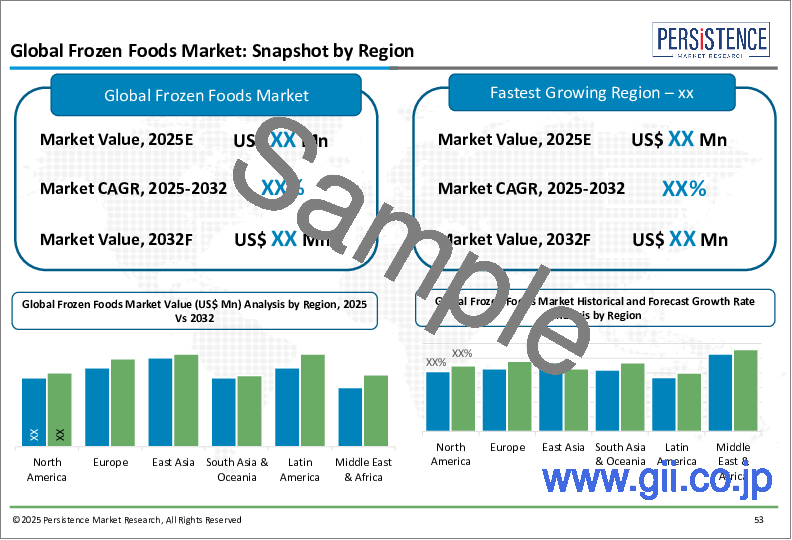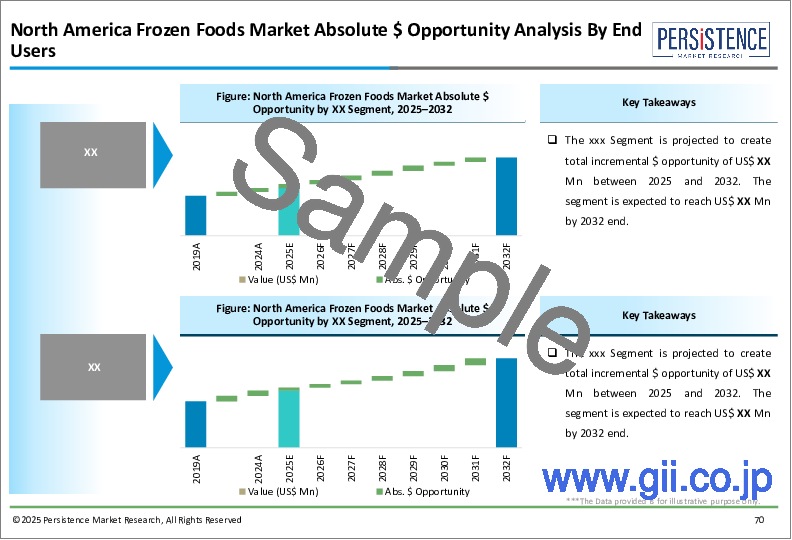|
|
市場調査レポート
商品コード
1684495
冷凍食品の世界市場:産業分析、規模、シェア、成長、動向、予測(2025年~2032年)Frozen Foods Market: Global Industry Analysis, Size, Share, Growth, Trends, and Forecast, 2025 - 2032 |
||||||
カスタマイズ可能
|
|||||||
| 冷凍食品の世界市場:産業分析、規模、シェア、成長、動向、予測(2025年~2032年) |
|
出版日: 2025年03月20日
発行: Persistence Market Research
ページ情報: 英文 177 Pages
納期: 2~5営業日
|
- 全表示
- 概要
- 目次
重要考察
- 冷凍食品の市場規模:3,111億米ドル(2025年)
- 予測される市場金額:1兆638億米ドル(2032年)
- 世界市場の成長率:19.20%(2025年~2032年のCAGR)
冷凍食品市場 - レポート範囲
冷凍食品市場には、鮮度、風味、栄養価を維持するために氷点下の温度で保存される幅広い食品が含まれます。このカテゴリには、惣菜、魚介類、肉類、乳製品、果物、野菜、ベーカリー製品、コンビニエンスフードが含まれます。便利で長持ちする食品に対する消費者の選好の変化、冷凍技術の進歩、フードサービス産業における冷凍食品需要の増加により、市場は急速な成長を示しています。
市場成長の促進要因
世界の冷凍食品市場は、消費者のライフスタイルの変化、都市化の進行、便利で時間を節約できる食事ソリューションに対する選好の高まりなど、複数の主な要因によって牽引されています。IQF(個別急速冷凍)技術などの冷凍技術の技術的進歩は、製品の品質を高め、保存可能期間を延ばし、市場の拡大をさらに後押ししています。クイックサービスレストラン(QSR)、カフェ、小売店による冷凍食品の採用の拡大も、市場成長に大きく寄与しています。さらに、植物由来の冷凍食品やオーガニック冷凍製品に対する需要の高まりが、新たな市場動向を形成しています。
市場抑制要因
有望な成長にもかかわらず、冷凍食品市場は、冷凍製品の食感や風味の喪失に関する懸念や、生鮮食品と比較した冷凍食品の栄養価に関する消費者の認識など、複数の課題に直面しています。特に発展途上地域では、コールドチェーンインフラの維持に対する保管と輸送のコストも大きな障壁となります。さらに、一部の冷凍食品には保存料が含まれているため、消費者の選択に影響を与え、生鮮食品または最小限の加工を施した代替の食品が好まれる可能性があります。
市場機会
冷凍食品市場は、包装、保存技術、健康的な冷凍食品の開発におけるイノベーションを通じて、大きな成長機会をもたらします。拡大するeコマースプラットフォームとオンライン食料品配送サービスは、冷凍食品へのアクセシビリティを高め、メーカーに新たな収益源をもたらしています。さらに、オーガニックのクリーンラベル冷凍食品の台頭は、持続可能で環境にやさしい食品の選択に対する消費者の意識の高まりもあり、市場拡大の新たな道を開いています。冷凍食品メーカーと小売チェーンとのパートナーシップは、売上と市場浸透をさらに促進することができます。
当レポートでは、世界の冷凍食品市場について調査し、成長促進要因、動向、機会、課題などの市場力学の詳細な分析を提供しています。
目次
第1章 エグゼクティブサマリー
第2章 市場の概要
- 市場の範囲と定義
- 市場力学
- 促進要因
- 抑制要因
- 機会
- 課題
- 主要動向
- 冷凍食品市場:バリューチェーン
- 主要企業のリスト
- 予測要因 - 関連性と影響
- COVID-19の影響の評価
- PESTLE分析
- ポーターのファイブフォース分析
第3章 価格動向の分析(2019年~2032年)
- 価格に影響を与える主な要因
- 価格:製品タイプ別
第4章 世界の冷凍食品市場の見通し(2019年~2032年)
- 市場規模の分析と予測
- 市場規模の実績の分析(2019年~2024年)
- 現在の市場規模の予測(2025年~2032年)
- 世界の冷凍食品市場の見通し:製品タイプ
- 市場規模の実績の分析:製品タイプ別(2019年~2024年)
- 現在の市場規模の予測:製品タイプ別(2025年~2032年)
- 市場の魅力分析:製品タイプ
- 世界の冷凍食品市場の見通し:性質
- 市場規模の実績の分析:性質別(2019年~2024年)
- 現在の市場規模の予測:性質別(2025年~2032年)
- 市場の魅力分析:性質
第5章 世界の冷凍食品市場の見通し:地域
- 市場規模の実績の分析:地域別(2019年~2024年)
- 現在の市場規模の予測:地域別(2025年~2032年)
- 北米
- 欧州
- 東アジア
- 南アジア・オセアニア
- ラテンアメリカ
- 中東・アフリカ
- 市場の魅力分析:地域
第6章 北米の冷凍食品市場の見通し(2019年~2032年)
第7章 欧州の冷凍食品市場の見通し(2019年~2032年)
第8章 東アジアの冷凍食品市場の見通し(2019年~2032年)
第9章 南アジア・オセアニアの冷凍食品市場の見通し(2019年~2032年)
第10章 ラテンアメリカの冷凍食品市場の見通し(2019年~2032年)
第11章 中東・アフリカの冷凍食品市場の見通し(2019年~2032年)
第12章 競合情勢
- 市場シェアの分析(2025年)
- 市場構造
- 競合強度マップ:市場別
- 競合ダッシュボード
- Tier構造の分析
- 地域のプレゼンスの分析
- 企業プロファイル(詳細 - 概要、財務、戦略、近年の発展)
- Ajinomoto Co., Inc.
- Arytza AG
- Associated British Foods Plc
- Cargill, Incorporated
- Conagra Brands
- General Mills Inc.
- JBS Brazil
- Kellogg's Company
- McCain Foods
- Nestle SA
- The Kraft Heinz Company
- その他
第13章 付録
Persistence Market Research has recently released a comprehensive report on the global Frozen Foods Market, providing an in-depth analysis of key market dynamics, including driving forces, emerging trends, opportunities, and challenges. This report offers a detailed understanding of the market landscape, helping stakeholders make well-informed decisions.
Key Insights:
- Frozen Foods Market Size (2025E): US$ 311.1 Bn
- Projected Market Value (2032F): US$ 1,063.80 Bn
- Global Market Growth Rate (CAGR 2025 to 2032): 19.20%
Frozen Foods Market - Report Scope:
The Frozen Foods market includes a wide range of food products that are preserved at sub-zero temperatures to maintain their freshness, taste, and nutritional value. This category encompasses ready meals, seafood, meat, dairy, fruits, vegetables, bakery items, and convenience foods. The market is experiencing rapid growth due to shifting consumer preferences for convenient and long-lasting food options, advancements in freezing technology, and increasing demand for frozen meals in the foodservice industry.
Market Growth Drivers:
The global Frozen Foods market is being driven by several key factors, including changing consumer lifestyles, increasing urbanization, and a rising preference for convenient and time-saving meal solutions. Technological advancements in freezing techniques, such as IQF (Individually Quick Frozen) technology, enhance product quality and extend shelf life, further fueling market expansion. The growing adoption of frozen food products by quick-service restaurants (QSRs), cafes, and retail stores is also a significant contributor to market growth. Additionally, the rising demand for plant-based frozen foods and organic frozen products is shaping new market trends.
Market Restraints:
Despite its promising growth, the Frozen Foods market faces several challenges, including concerns regarding the loss of texture and taste in frozen products and consumer perceptions about the nutritional value of frozen food compared to fresh food. Storage and transportation costs for maintaining the cold chain infrastructure can also be a significant barrier, particularly in developing regions. Additionally, the presence of preservatives in some frozen products may affect consumer choices, leading to a preference for fresh or minimally processed alternatives.
Market Opportunities:
The Frozen Foods market presents significant opportunities for growth through innovations in packaging, preservation techniques, and the development of healthier frozen meal options. Expanding e-commerce platforms and online grocery delivery services are increasing the accessibility of frozen food products, providing new revenue streams for manufacturers. Additionally, the rise in organic and clean-label frozen foods, coupled with increasing consumer awareness of sustainable and eco-friendly food choices, is opening new avenues for market expansion. Partnerships between frozen food producers and retail chains can further drive sales and market penetration.
Key Questions Answered in the Report:
- What are the key factors driving the global growth of the Frozen Foods market?
- Which product segments are witnessing the highest demand in the frozen food industry?
- How are advancements in freezing and packaging technologies influencing market trends?
- Who are the major players in the Frozen Foods market, and what strategies are they using to maintain their competitive position?
- What are the emerging trends and future growth prospects in the global Frozen Foods market?
Competitive Intelligence and Business Strategy:
Leading companies in the global Frozen Foods market, such as Ajinomoto Co., Inc., Arytza AG, and Nestle S.A., are focusing on product innovation, supply chain optimization, and expansion into emerging markets to strengthen their market presence. These companies are leveraging advanced freezing technologies and sustainable packaging solutions to enhance product quality and extend shelf life. Strategic collaborations with foodservice providers, grocery retailers, and e-commerce platforms are helping key players expand their customer base. Additionally, companies are investing in organic and plant-based frozen food offerings to cater to health-conscious consumers and evolving dietary preferences.
Key Companies Profiled:
- Ajinomoto Co., Inc.
- Arytza AG
- Associated British Foods Plc
- Cargill, Incorporated
- Conagra Brands
- General Mills Inc.
- JBS Brazil
- Kellogg's Company
- McCain Foods
- Nestle S.A.
- The Kraft Heinz Company
- Others
Frozen Foods Industry Research by Category:
By Product Type:
- Ready Meals
- Fish/Seafood
- Meat
- Dairy Products
- Fruits & Vegetables
- Pizza & Pasta
- Bakery Products
By Nature:
- Organic
- Conventional
By Region:
- North America
- Latin America
- Europe
- East Asia
- South Asia & Pacific
- The Middle East & Africa
Table of Contents
1. Executive Summary
- 1.1. Global Frozen Foods Market Snapshot, 2025 and 2032
- 1.2. Market Opportunity Assessment, 2025-2032, US$ Bn
- 1.3. Key Market Trends
- 1.4. Future Market Projections
- 1.5. Industry Developments and Key Market Events
- 1.6. PMR Analysis and Recommendations
2. Market Overview
- 2.1. Market Scope and Definition
- 2.2. Market Dynamics
- 2.2.1. Drivers
- 2.2.2. Restraints
- 2.2.3. Opportunity
- 2.2.4. Challenges
- 2.2.5. Key Trends
- 2.3. Frozen Foods Market: Value Chain
- 2.3.1. List of key players
- 2.4. Forecast Factors - Relevance and Impact
- 2.5. Covid-19 Impact Assessment
- 2.6. PESTLE Analysis
- 2.7. Porter Five Force's Analysis
3. Price Trend Analysis, 2019-2032
- 3.1. Key Factors Impacting Prices
- 3.2. Prices by Product Type
4. Global Frozen Foods Market Outlook, 2019-2032
- 4.1. Market Size (US$ Bn) Analysis and Forecast
- 4.1.1. Historical Market Size Analysis, 2019-2024
- 4.1.2. Current Market Size Forecast, 2025-2032
- 4.2. Global Frozen Foods Market Outlook: Product Type
- 4.2.1. Historical Market Size (US$ Bn) Analysis By Product Type, 2019-2024
- 4.2.2. Current Market Size (US$ Bn) Forecast By Product Type, 2025-2032
- 4.2.2.1. Ready Meals
- 4.2.2.2. Fish/Seafood
- 4.2.2.3. Meat
- 4.2.2.4. Dairy Products
- 4.2.2.5. Fruits & Vegetables
- 4.2.2.6. Pizza & Pasta
- 4.2.2.7. Bakery products
- 4.2.3. Market Attractiveness Analysis: Product Type
- 4.3. Global Frozen Foods Market Outlook: Nature
- 4.3.1. Historical Market Size (US$ Bn) Analysis By Nature, 2019-2024
- 4.3.2. Current Market Size (US$ Bn) Forecast By Nature, 2025-2032
- 4.3.2.1. Organic
- 4.3.2.2. Conventional
- 4.3.3. Market Attractiveness Analysis: Nature
5. Global Frozen Foods Market Outlook: Region
- 5.1. Historical Market Size (US$ Bn) Analysis By Region, 2019-2024
- 5.2. Current Market Size (US$ Bn) Forecast By Region, 2025-2032
- 5.2.1. North America
- 5.2.2. Europe
- 5.2.3. East Asia
- 5.2.4. South Asia and Oceania
- 5.2.5. Latin America
- 5.2.6. Middle East & Africa
- 5.3. Market Attractiveness Analysis: Region
6. North America Frozen Foods Market Outlook, 2019-2032
- 6.1. Historical Market Size (US$ Bn) Analysis By Market, 2019-2024
- 6.1.1. By Country
- 6.1.2. By Product Type
- 6.1.3. By Nature
- 6.2. Current Market Size (US$ Bn) Forecast By Country, 2025-2032
- 6.2.1. U.S.
- 6.2.2. Canada
- 6.3. Current Market Size (US$ Bn) Forecast By Product Type, 2025-2032
- 6.3.1. Ready Meals
- 6.3.2. Fish/Seafood
- 6.3.3. Meat
- 6.3.4. Dairy Products
- 6.3.5. Fruits & Vegetables
- 6.3.6. Pizza & Pasta
- 6.3.7. Bakery products
- 6.4. Current Market Size (US$ Bn) Forecast By Nature, 2025-2032
- 6.4.1. Organic
- 6.4.2. Conventional
- 6.5. Market Attractiveness Analysis
7. Europe Frozen Foods Market Outlook, 2019-2032
- 7.1. Historical Market Size (US$ Bn) Analysis By Market, 2019-2024
- 7.1.1. By Country
- 7.1.2. By Product Type
- 7.1.3. By Nature
- 7.2. Current Market Size (US$ Bn) Forecast By Country, 2025-2032
- 7.2.1. Germany
- 7.2.2. France
- 7.2.3. U.K.
- 7.2.4. Italy
- 7.2.5. Spain
- 7.2.6. Russia
- 7.3. Current Market Size (US$ Bn) Forecast By Product Type, 2025-2032
- 7.3.1. Ready Meals
- 7.3.2. Fish/Seafood
- 7.3.3. Meat
- 7.3.4. Dairy Products
- 7.3.5. Fruits & Vegetables
- 7.3.6. Pizza & Pasta
- 7.3.7. Bakery products
- 7.4. Current Market Size (US$ Bn) Forecast By Nature, 2025-2032
- 7.4.1. Organic
- 7.4.2. Conventional
- 7.5. Market Attractiveness Analysis
8. East Asia Frozen Foods Market Outlook, 2019-2032
- 8.1. Historical Market Size (US$ Bn) Analysis By Market, 2019-2024
- 8.1.1. By Country
- 8.1.2. By Product Type
- 8.1.3. By Nature
- 8.2. Current Market Size (US$ Bn) Forecast By Country, 2025-2032
- 8.2.1. China
- 8.2.2. Japan
- 8.2.3. South Korea
- 8.3. Current Market Size (US$ Bn) Forecast By Product Type, 2025-2032
- 8.3.1. Ready Meals
- 8.3.2. Fish/Seafood
- 8.3.3. Meat
- 8.3.4. Dairy Products
- 8.3.5. Fruits & Vegetables
- 8.3.6. Pizza & Pasta
- 8.3.7. Bakery products
- 8.4. Current Market Size (US$ Bn) Forecast By Nature, 2025-2032
- 8.4.1. Organic
- 8.4.2. Conventional
- 8.5. Market Attractiveness Analysis
9. South Asia & Oceania Frozen Foods Market Outlook, 2019-2032
- 9.1. Historical Market Size (US$ Bn) Analysis By Market, 2019-2024
- 9.1.1. By Country
- 9.1.2. By Product Type
- 9.1.3. By Nature
- 9.2. Current Market Size (US$ Bn) Forecast By Country, 2025-2032
- 9.2.1. India
- 9.2.2. Southeast Asia
- 9.2.3. ANZ
- 9.2.4. Rest of South Asia & Oceania
- 9.3. Current Market Size (US$ Bn) Forecast By Product Type, 2025-2032
- 9.3.1. Ready Meals
- 9.3.2. Fish/Seafood
- 9.3.3. Meat
- 9.3.4. Dairy Products
- 9.3.5. Fruits & Vegetables
- 9.3.6. Pizza & Pasta
- 9.3.7. Bakery products
- 9.4. Current Market Size (US$ Bn) Forecast By Nature, 2025-2032
- 9.4.1. Organic
- 9.4.2. Conventional
- 9.5. Market Attractiveness Analysis
10. Latin America Frozen Foods Market Outlook, 2019-2032
- 10.1. Historical Market Size (US$ Bn) Analysis By Market, 2019-2024
- 10.1.1. By Country
- 10.1.2. By Product Type
- 10.1.3. By Nature
- 10.2. Current Market Size (US$ Bn) Forecast By Country, 2025-2032
- 10.2.1. Brazil
- 10.2.2. Mexico
- 10.3. Current Market Size (US$ Bn) Forecast By Product Type, 2025-2032
- 10.3.1. Ready Meals
- 10.3.2. Fish/Seafood
- 10.3.3. Meat
- 10.3.4. Dairy Products
- 10.3.5. Fruits & Vegetables
- 10.3.6. Pizza & Pasta
- 10.3.7. Bakery products
- 10.4. Current Market Size (US$ Bn) Forecast By Nature, 2025-2032
- 10.4.1. Organic
- 10.4.2. Conventional
- 10.5. Market Attractiveness Analysis
11. Middle East & Africa Frozen Foods Market Outlook, 2019-2032
- 11.1. Historical Market Size (US$ Bn) Analysis By Market, 2019-2024
- 11.1.1. By Country
- 11.1.2. By Product Type
- 11.1.3. By Nature
- 11.2. Current Market Size (US$ Bn) Forecast By Country, 2025-2032
- 11.2.1. GCC
- 11.2.2. South Africa
- 11.2.3. Northern Africa
- 11.3. Current Market Size (US$ Bn) Forecast By Product Type, 2025-2032
- 11.3.1. Ready Meals
- 11.3.2. Fish/Seafood
- 11.3.3. Meat
- 11.3.4. Dairy Products
- 11.3.5. Fruits & Vegetables
- 11.3.6. Pizza & Pasta
- 11.3.7. Bakery products
- 11.4. Current Market Size (US$ Bn) Forecast By Nature, 2025-2032
- 11.4.1. Organic
- 11.4.2. Conventional
- 11.5. Market Attractiveness Analysis
12. Competition Landscape
- 12.1. Market Share Analysis, 2025
- 12.2. Market Structure
- 12.2.1. Competition Intensity Mapping By Market
- 12.2.2. Competition Dashboard
- 12.2.3. Tier Structure Analysis
- 12.2.4. Regional Presence Analysis
- 12.3. Company Profiles (Details - Overview, Financials, Strategy, Recent Developments)
- 12.3.1. Ajinomoto Co., Inc.
- 12.3.1.1. Overview
- 12.3.1.2. Segments and Product Types
- 12.3.1.3. Key Financials
- 12.3.1.4. Market Developments
- 12.3.1.5. Market Strategy
- 12.3.2. Arytza AG
- 12.3.3. Associated British Foods Plc
- 12.3.4. Cargill, Incorporated
- 12.3.5. Conagra Brands
- 12.3.6. General Mills Inc.
- 12.3.7. JBS Brazil
- 12.3.8. Kellogg's Company
- 12.3.9. McCain Foods
- 12.3.10. Nestle S.A.
- 12.3.11. The Kraft Heinz Company
- 12.3.12. Others
- 12.3.1. Ajinomoto Co., Inc.
13. Appendix
- 13.1. Research Methodology
- 13.2. Research Assumptions
- 13.3. Acronyms and Abbreviations






